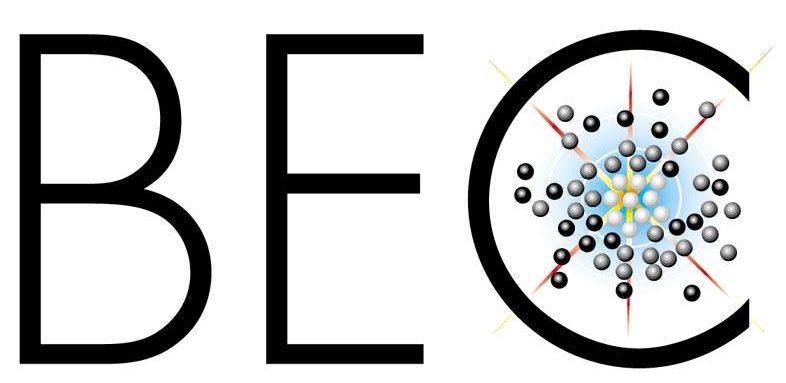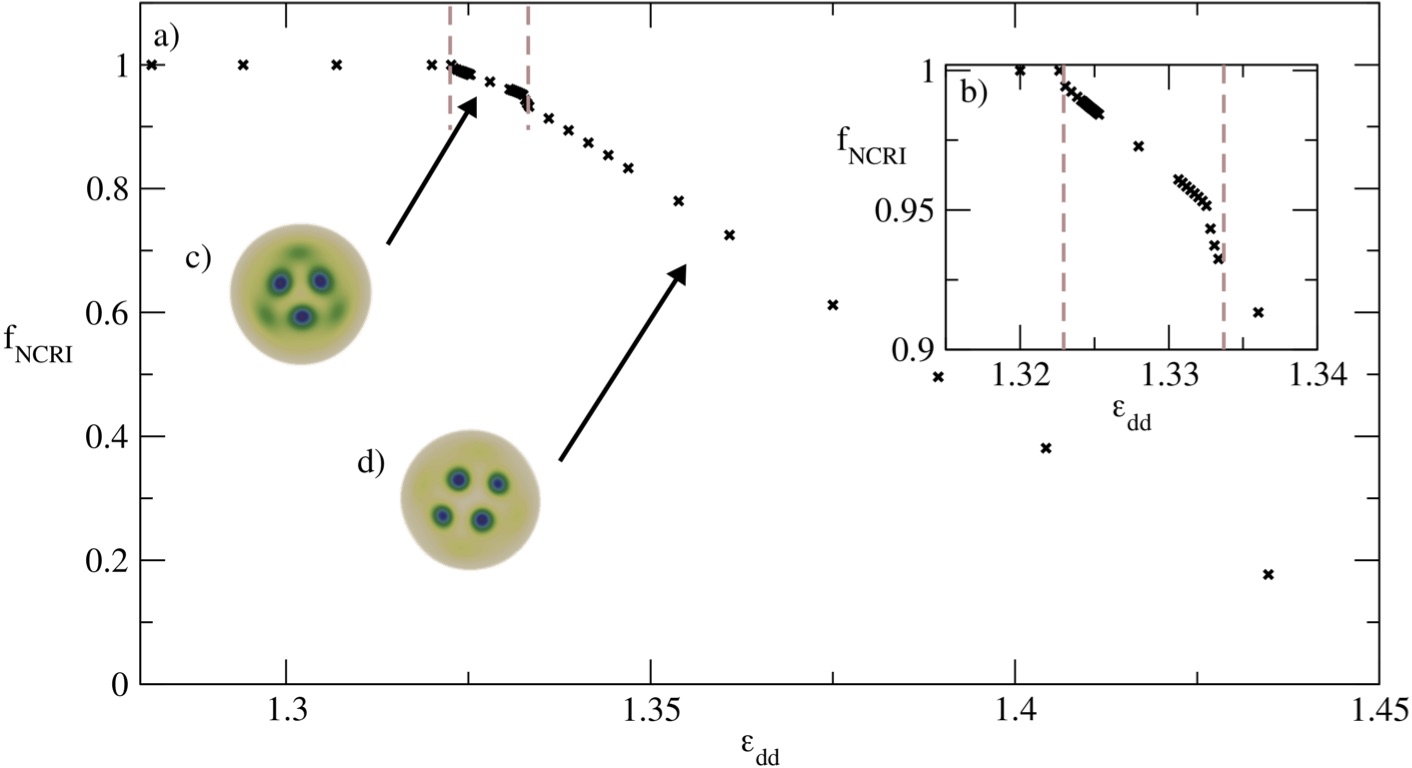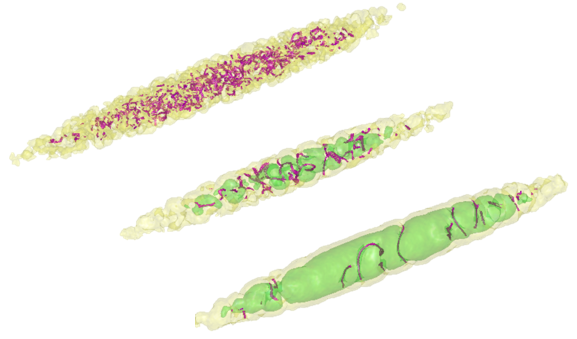
Pitaevskii Center on Bose-Einstein Condensation
Trento, Italy
Theory of quantum gases and fluids
Principal investigators: Iacopo Carusotto, Franco Dalfovo, Stefano Giorgini, Chiara Menotti, Alessio Recati, Sandro Stringari.
Postdocs: Soumik Bandyopadhyay, Christian H. Johansen
PhD students: Otto Schmidt, Alberto Tabarelli de Fatis, Tomasz Zawislak
Main research field:
- THEORY OF BOSE GASES AND BOSE-EINSTEIN CONDENSATES
- THEORY OF FERMI GASES
- QUANTUM MIXTURES, QUANTUM IMPURITIES, POLARONS
- SUPERFLUIDITY AND SUPERSOLIDITY
- DIPOLAR GASES
- MULTICOMPONENT AND COHERENTLY COUPLED CONDENSATES
- LOW DIMENSIONAL SYSTEM
- MODELS FOR ATOMS IN OPTICAL LATTICES
- TOPOLOGICAL PHASES OF MATTER
- ANALOG MODELS
Methods: Basic tools of statistical mechanics; hydrodynamic equations and models; mean-field approaches like Gross-Pitaevskii theory, Bogoliubov equations, BCS theory; sum rules; Quantum Monte Carlo; Bose-Hubbard and Fermi-Hubbard models; Density Matrix Renormalization group; Tensor Networks.
Recent PhD theses:
-
Solitons in Magnetic Systems
- Marija Sindik (2025) Quantized Vortices and Sound Velocities in Dipolar Supersolids
- Sebastiano Bresolin (2024) Solitons in Magnetic Systems
- Anna Berti (2024) Simulation of curved-space quantum field theories with two-component Bose-Einstein condensates: from black-hole physics to cosmology
- Daniele Contessi (2023), Data driven approach to detection of quantum phase transitions
- Kevin T. Geier (2022), Probing Dynamics and Correlations in Cold-Atom Quantum Simulators
- Matteo Sighinolfi (2022), Open quantum systems and ultracold atoms
- Santo Maria Roccuzzo (2021), Supersolidity in a dipolar quantum gas
- Miki Ota (2020), Sound propagation in dilute Bose gases
- Luca Parisi (2019), Mixtures of ultracold Bose gases in one dimension: A Quantum Monte Carlo study
- Fabrizio Larcher (2018), Dynamical excitations in low-dimensional condensates: sound, vortices and quenched dynamics
- Giulia De Rosi (2017), Collective oscillations of a trapped atomic gas in low dimensions and thermodynamics of one-dimensional Bose gas
- Alberto Sartori (2016), Dynamical properties of Bose-Bose Mixtures
- Luis A. Peña Ardila (2015), Impurities in a Bose-Einstein condensate using quantum Monte-Carlo methods: ground-state properties
- Giovanni Italo Martone (2014), Static and dynamic properties of spin-orbit-coupled Bose-Einstein condensates
- Zou Peng (2014), Mean-field theory for the dynamics of superfluid fermions in the BCS-BEC crossover
- Hou Yan-Hua (2013), Two-fluid Hydrodynamics of a quasi-1D unitary Fermi gas
- Marco Larcher (2013), Localization and spreading of matter waves in disordered potentials
- Natalia Matveeva (2013), Study of dynamic and ground-state properties of dipolar Fermi gases using mean-field and quantum Monte Carlo methods
- Gianluca Bertaina (2010), Study of Ultracold Fermi Gases in the BCS-BEC Crossover: Quantum Monte Carlo Methods, Hydrodynamics and Local Density Approximation
- Ingrid Bausmerth (2009), Fermi Mixtures: Effects of Engineered Confinements
DIPOLAR GASES
Sound and hydrodyanmics of supersolids
We propose a protocol to excite the Goldstone modes of a supersolid dipolar Bose-Einstein con-
densed gas confined in a ring geometry. By abruptly removing an applied periodic modulation
along the ring, we explore the resulting oscillations of the
gas, by solving the extended Gross-Pitaevskii equation. The value of the two longitudinal sound
velocities exhibited in the supersolid phase are analyzed using the hydrodynamic theory of super-
solids at zero temperature. This approach allows for the determination of the layer compressibility
modulus as well as of the superfluid fraction, in agreement with the Leggett estimate of the
non-classical moment of inertia
References:
Marija Sindik, Tomasz Zawislak, Alessio Recati, Sandro Stringari,
arXiv:2308.05981 ,

Rotating supersolids
A supersolid shows both solid and superfluid properties. By rotating it you can clearly
see that the moment of inertia is strongly reduced due to the superfluid irrotational flow.
Even when the global superfluid behaviour diseappers, the moment of inertia shows a reduction
due to the single droplet (local) superfluidity.
We have also characterized the behavior of quantized vortices, focusing on the supersolid regime.
We have found in particular that (i) the angular momentum per particle associated with the vortex line is
smaller than ℏ, reflecting the reduction of the global superfluidity; (ii) the nucleation in
a rotating trap is triggered -- as for a standard condensate -- by the softening of the quadrupole mode;
(iii) many vortices can be arranged into a honeycomb structure, which coexists with the triangular
geometry of the supersolid lattice and persists during the free expansion of the atomic cloud.
We have very recently provided a new protocol for the generation of vortices and their experimental detection.
References:
S. M. Roccuzzo, A. Gallemì, A. Recati, S. Stringari,
arXiv:1910.08513,
Phys. Rev. Lett. 124, 045702 (2020)
A. Gallemì, S. M. Roccuzzo, S. Stringari, A. Recati,
arXiv:2005.05718, Phys. Rev. A 102, 023322 (2020)
Marija Sindik, Alessio Recati, Santo Maria Roccuzzo, Luis Santos, Sandro Stringari,
arXiv:2206.14100, Phys. Rev. A 106, L061303 (2022)


LATTICE MODELS
Quantum Gutzwiller approach
We have developed the equivalent of Bogoliubov theory (for weakly interacting Bose gases) for the lattice models, but starting from the Gutzwiller ansatz. We find that the approach is extremely well suited to calculate the correlations of the systems. The model is benchmarked against the available QMC result. We develop the formalism for the single component Hubbard model as well as for the 2-component Hubbard model. We applied the new approach in the study of impurities problems. In particular we study the effect of strong correlation in the Hubbard bath and of the phase transition on the dephasing mdel, as well as on the properties of the Bose-lattice polaron problem.
Reference:
F. Caleffi, M. Capone, C. Menotti, I. Carusotto, A. Recati,
arXiv:1910.08513, Phys. Rev. Research 2, 033276 (2020)
Fabio Caleffi, Massimo Capone, Ines de Vega, Alessio Recati,
arXiv:2011.13757, New J. Phys. 23 033018 (2021)
V. E. Colussi, F. Caleffi, C. Menotti, A. Recati,
arXiv:2110.13095 , SciPost Phys. 12, 111 (2022)
V. E. Colussi, F. Caleffi, C. Menotti, A. Recati,
arXiv:2205.09857, Phys. Rev. Lett. 130, 173002 (2023)

Data science
In a collaboration with Prof. Matteo Rizzi (Julich/Köln Univ.) we started a project aimed at revealing phase transitions and describing phase diagrams of lattice Hamiltonian with minimal a priori knowledge. Within the collaboration we have shown how to apply state-of-the-art neural network architecture to the entanglement spectrum to identify various phase transition and in particular the subtle Berezinski-Kosterlitz-Thouless one. Moreover we identify the number counting statistcs as a very promising experimental and theoretical quantity to identify the existence of different phases, including a topological (Haldane phase) one.
Reference:
Daniele Contessi, Alessio Recati, and Matteo Rizzi,
arXiv:2110.05383 , SciPost Phys. 12, 107 (2022)
Daniele Contessi, Alessio Recati, and Matteo Rizzi,
arXiv:2207.01478, Phys. Rev. B 107, L121403 (2023)

Stochastic Gross-Pitaevskii Equation and Kibble-Zurek Mechanism
We study the dynamical evolution of an inhomogeneous ultracold atomic gas quenched at different controllable rates through the Bose-Einstein condensation phase transition. We use a stochastic (projected) Gross-Pitaevskii equation. The results are consistent with the predictions of the homogeneous Kibble-Zurek mechanism and, at long evolution times, also with the experimental observations.
References:
I.-Kang Liu, S. Donadello, G. Lamporesi, G. Ferrari, S.-C. Gou, F. Dalfovo, N.P. Proukakis,
arXiv:1712.08074,
Commun. Phys. 1, 24 (2018)
I-Kang Liu, Jacek Dziarmaga, Shih-Chuan Gou, Franco Dalfovo, Nick P. Proukakis,
arXiv:2004.09642,
Phys. Rev. Research, in press (2020)
